It’s an interesting camera the Zeiss Ikon. They seem to garner a level of approval that’s often vocalised in broad sweeping terms such as “better than a Leica”. Yet despite this, they don’t seem to be all that common. Being a big fan of the Leica M7, I must admit that I have for a long time been a little more than intrigued by these claims. In fact, prior to my decision to buy a Leica M7, I flirted with the idea of a Zeiss Ikon for quite a while. In the end though, a combination of not being able to find one in good enough condition, and having a sinking feeling that I’d just end up selling it to buy a Leica meant that I just paid an extra few quid and bought the M7. The irony is, some two years down the line I’ve just sold the Leica M7 and bought – you guessed it – a Zeiss Ikon…
Before I get into the meat of this review, I just want to back track a little to where I was in my film photography journey when I bought the Leica. The M7 wasn’t my first Leica, though it was the first I bought since I started this blog. At the time, I wanted a metered camera, and moreover I wanted a level of automation. I bought the Leica M7 and very quickly discovered that it was pretty much perfect for my needs. Nearly 2 years have passed since then, and in that time my needs have changed. Not drastically – I still feel a M-mount camera to be perfect for my needs – I just don’t have the need for a built in light meter in the way I used to. But more than that, I also don’t find levels of automation the Leica M7 offers as useful as I used to either.
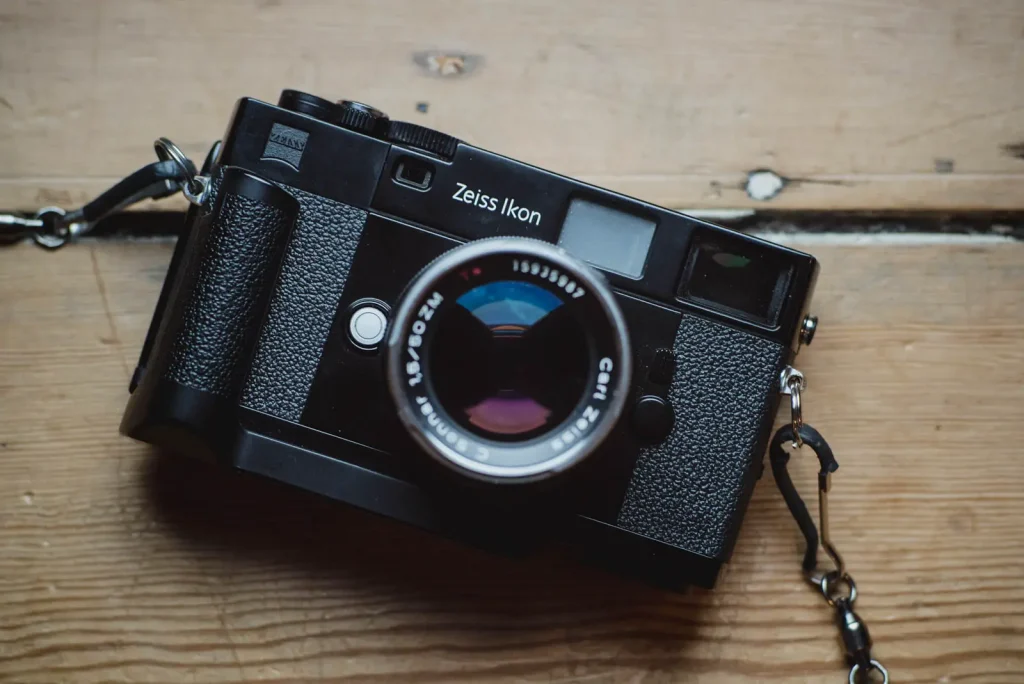
So why buy a Zeiss Ikon? Being honest, I think perhaps an element of the decision to buy it was motivated by the sense of it providing a safety net. Read my M7 review and you’ll see just how committed to that style of shooting I was only 2 years ago. Selling it feels like a big step; having something that offers similar function makes me worry less about taking that step. The aforementioned intrigue is a factor too – I like playing with cameras, getting to know their various merits and writing about them. I also wonder if this Zeiss Ikon can bring something to the table more than the M7, something that will find it a place along side the M-A and M3 in my permanent kit bag. One thing is for sure, despite its obvious similarities, as soon as you pick the Zeiss Ikon up, you realise it’s a very different beast to any Leica.
The Zeiss Ikon review
Those who read my camera reviews regularly might have noted that they tend to follow one of two patterns. The first is where I just ramble my way through what I want to say allowing the odd tangent to take me now and then. The second is where I talk more factually about various functions of the camera in some sort of semi-planned order. This review is definitely more toward the latter. I mention this as I feel there is a correlation between how I write and how I feel about the camera. A camera like the Rollei 35se for example, I felt almost besotted by its charm. This became something that inspired me to write a post that veered into the merits of an entire shooting style and how that particular camera was so perfect for said style.
This camera has not inspired such a response in me, the Zeiss Ikon feels like a camera I need to be more objective about. It feels like the facts need to be stated about it, because actually, it feels to me like it was built on facts. I will touch on this throughout the review, but looking at the Zeiss Ikon, I can’t help just seeing a camera that has been analytically designed to be objectively better than a Leica. Not in all ways, but just in the ways that are going to most speak to those who seek a camera that’s technically and objectively better at a job, rather than subjectivity more enjoyable to use.
The Zeiss Ikon in the hand
First impressions of a camera for me start with the moment I pick one one up. And actually I think picking a Zeiss Ikon up is enough to make you realise how different one is from a Leica. The Zeiss Ikon feels lighter weight. The feel of the camera is one of pressed metal rather than cast (though I have no idea how it was made). The body plates feel thiner, where a Leica’s feel solid. This is not a crime, pressed/thinner metal is just as valid a material to make a camera out of as cast. For a start it has the obvious advantage of being lighter weight, especially when the chosen material is aluminium as I believe it is in the Zeiss Ikon. In fact, this is what I see as the first technical improvement over the Leica equivalent; for some, a lighter weight camera is something that can be carried for longer without fatigue. Oskar Barnack himself would I’m sure be impressed by the use of lighter materials in cameras like the Zeiss Ikon.
Of course, as I’ve unfortunately discovered, it’s also easier to damage. This is the bottom of my Ikon, it shows damage that I don’t even remember inflicting. I’ve dropped Leicas, from a height, and done more damage to the floor than I have the camera – and that’s not an exaggeration.
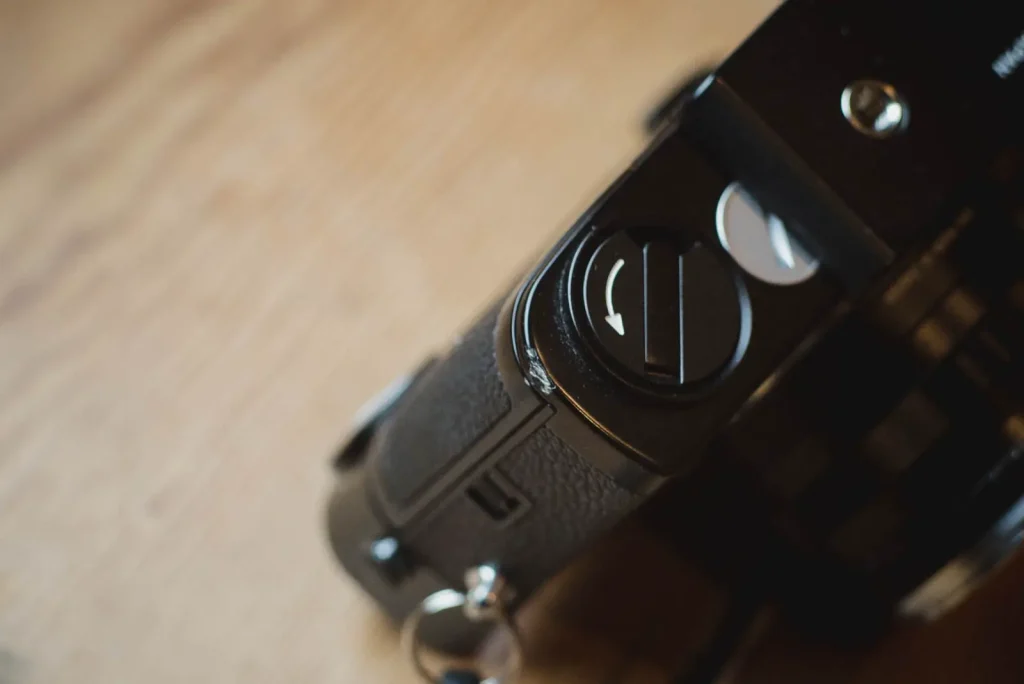
I’m also not entirely convinced that the Zeiss Ikon really gives of as much of a sense of build quality as I think it could. When holding a Voigltlander R2a for example, it’s very easy to feel the gap in quality between it and a Leica. The gap in build quality is still there between the Zeiss Ikon and a Leica, though being fair to it, the gap is definitely a lot smaller.
The shutter advance
The shutter advance is possibly one of the most obvious example of this slightly lesser-than-Leica refinement of build. It has a short throw advance which means is quick and makes the camera feel responsive. It’s also made entirely of metal, which appeals to my personal tastes. What lets it down is a looseness to its travel that makes it feel less precise than a Leica’s sprung mount and very smooth film advance.
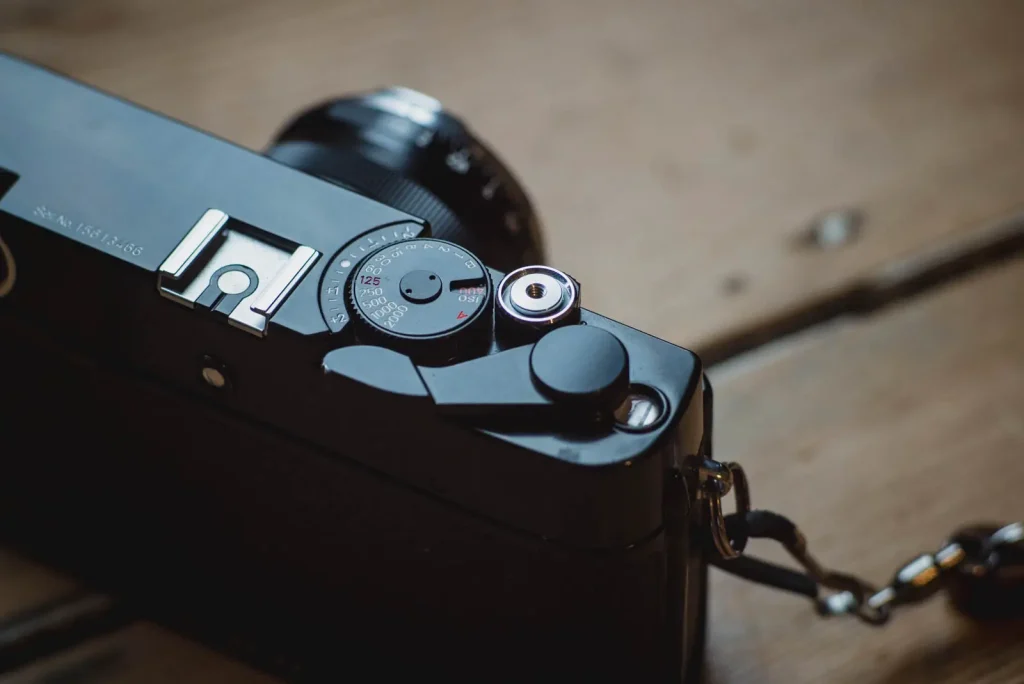
Shutter dial
Many of the individual parts of the camera feel slightly less solid too. Like the Voigtlander series of AE rangefinders the Zeiss Ikon has the shutter speeds, ISO selection and exposure compensation all built into one dial. In terms of its function, it’s a perfect design really, it just doesn’t feel as robust as a solid metal dial you’d find on a Leica.
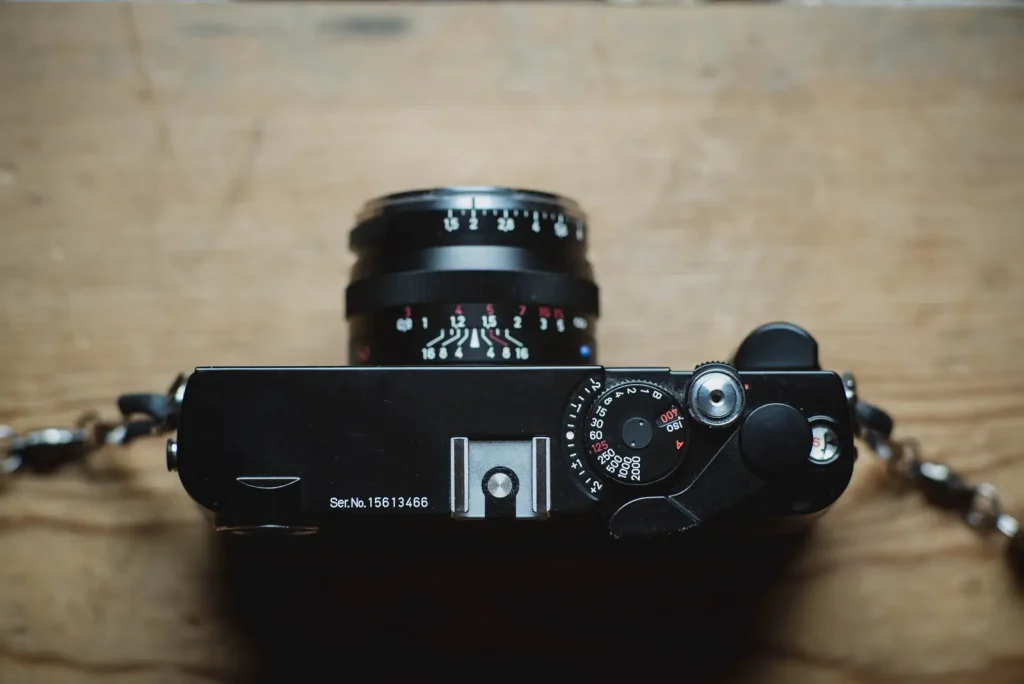
That said, if you compare it directly to the Leica M7 with its crappy plastic ISO/exposure compensation dial on the back, the playing fields all of a sudden feels a lot more level.
Inside the camera
Leica aren’t the only ones to use plastics in their cameras… Opening up the back of the Zeiss Ikon is where the use of such materials becomes evident. Like in the massive majority of cameras build since the 70’s, the Zeiss Ikon has internal components made of plastic, not least the take up spool. Is this a real concern? No I’d say it probably isn’t. If you are looking for a camera to outlive you, it might make you think twice, but in real terms there is nothing wrong with the use of plastic in a camera like this. It keeps things lighter for a start. Depending on how old you are, you just might not be passing this camera down to you’re kids like you might be able to with a Leica M-A.
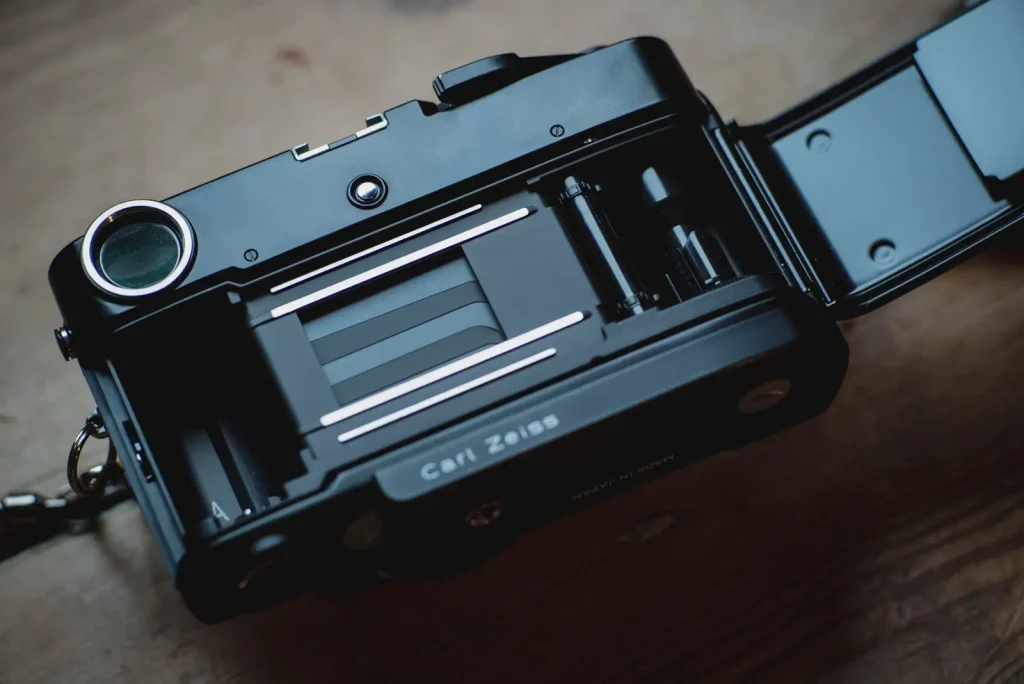
The shutter
Since the shutter is electronically controlled, the Zeiss ikon is completely reliant on batteries. Once again, through the potential for failure of electronics, this could mean the Zeiss Ikon is less likely to out live you than a Leica… Unless the Leica is an M7, which is also electronically controlled and therefore probably just as likely to fail. Of course this is all fairly unreasonable, there are very few things in life that we buy with an expectation of them out living us. Mechanical film Leicas are an exception to this rule, and shouldn’t be used as a benchmark to judge a camera like this.
Vertical focal plane metal shutter
Interestingly, the Zeiss Ikon does have one thing that’s possibly more durable than the Leica equivalent. It’s shutter is metal rather than cloth. The later Leica digital cameras also have metal shutters, the reason being that cloth shutters just aren’t capable of speeds greater than 1/1000th of a second – some would even tell you that 1/1000 is a bit of an optimistic estimate for how fast a leicas top speed is. The Zeiss Ikon with its metal shutter beats this with a top speed of 1/2000th. Of course where there is advantage, there is also disadvantage; the disadvantage of a metal shutter is the potential for a louder shutter sound.
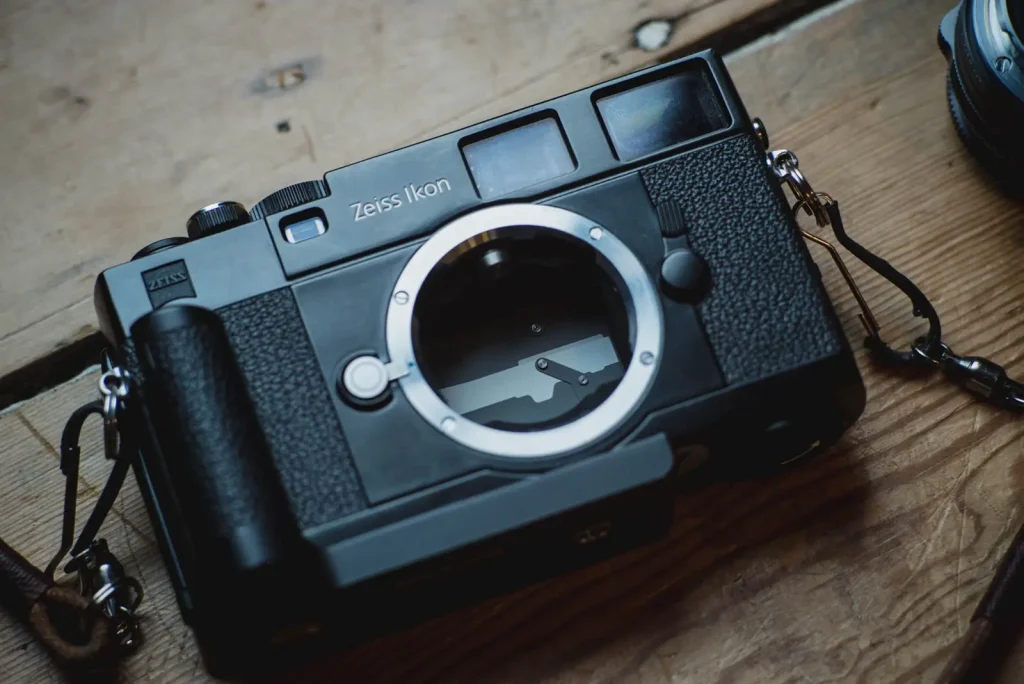
Shutter noise
I must admit, expectation bias initially made me think the shutter was loud. Being a metal bladed vertical shutter like the Voigtlander, I was expecting a much louder noise, or more accurately I was expecting it to sound like the Voigtlander does. It was only after shooting with the camera for a few films that I noticed it made a lot less noise than I thought it had been. It has the same, or at least similar more metallic sound of the Voigtlander series of cameras, yet I would say it’s more damped and less clacky than a Voigtlander. Regardless of this dampened sound though, it’s still a sound that I think draws more attention to itself than that of a cloth Leica shutter. Though I think you’d need to have desires to be fairly sneaky to feel like this is an issue.
The shutter release
I don’t think it is any exaggeration to say the shutter button on the Zeiss Ikon is one of, if not the best shutter buttons I’ve come across. A half press of the button to activate the lightmeter sits the finger on a really solid feeling shutter release action. When you press the shutter release fully, the buttons travel is so slight, and the action so abrupt that you really feel like you are in control of the moment the shutter fires. It’s very satisfying to use! The biggest issue I have with it is that the auto exposure lock isn’t activated at half press and is instead by a button on the back of the camera, but I’ll come back to that point later on.
The viewfinder
Advocates of the Zeiss Ikon ZM are always very quick to point out just how good the viewfinder is compared to Leica viewfinders. This really is one area where it feels like the intention was to better anything from the Leica stables. There’s good reason for this too, it is in fact both bigger and brighter than any of my Leica viewfinders, including the M-A, which is in its own right a stunning viewfinder. In fact, there are a great deal of advantages the Zeiss Ikon finder has over almost any other rangefinder viewfinder I can think of.
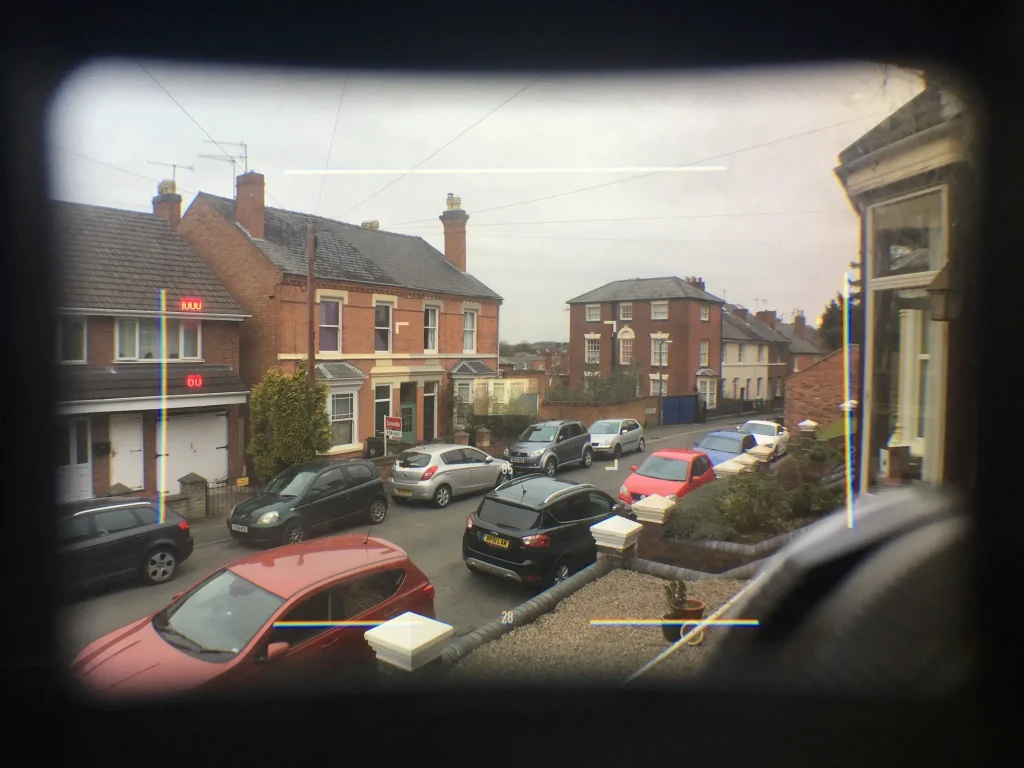
Frame lines
Unlike the 6 frame lines in 3 pairs that the standard modern Leica offers, the Zeiss Ikon only offers 4 conveniently labeled frame lines; 28, 35, 50 and 85. This surprised me to start with, but really, it’s obvious why the decision was made to exclude the extra lines. Quite simply, Zeiss don’t make a 75 or 135mm lens, as such, why would they include those lines? I suppose an obvious answer to that question could be to increase compatibility with other manufactures lenses, but for my needs, and I’m guessing the needs of many others I’m glad they didn’t.
My lens line up is made up of 28, 35, 50 and 90 mm lenses, and actually I think this is probably the most common line up of focal lengths people own for use with rangefinders. I personally see little need for a 75mm lens when I already only rarely use my 90mm. On top of this, 135mm is just too long for my tastes. So really, the Zeiss Ikon caters for the most common set of lenses. Additionally, thanks to the lack of extra lines, both 35mm and 50mm lines sit alone in the viewfinder. As I’ve said a few times on this blog, I don’t tend to be too fussed about what many people would call a “cluttered” viewfinder, but in the case of the Zeiss Ikon, it’s so big and so bright, that only seeing 35 and 50 lines when they are selected gives a user experience that is a step above any other rangefinder I’ve so far used. Including the likes of the Leica M2 which provides a similarly uncluttered view.
85mm vs. 90mm frame lines
Of course, you might question the choice of 85mm over 90mm lines? I really have no idea why Zeiss chose 85mm over 90mm for their telephoto focal length? But, for the sake of framing, the difference in frame line coverage between the 90mm lines in my M-A and the 85mm lines in the Zeiss Ikon is barely discernible. As such, shooting my 90mm elmarit-m on the Zeiss Ikon has posed me no concerns whatsoever. I have long accepted that framing with a rangefinder can be prone to inaccuracy anyway, so this minor frame line difference is likely no big deal in real life.
28mm frame line eye relief
At the opposite end the range there is the compatibility with wide angle lenses, specifically the 28mm focal length. Prior to trying the Ziess Ikon I’d read that the 28mm lines were more easily visible in the viewfinder when compared to a Leica. I’d definitely agree with this sentiment, but having tried the camera with my glasses on, I’m not convinced the eye relief is high enough for those who need glasses to shoot with. That said, there is definitely less requirement to peer side to side of the viewfinder in the way I find myself framing 28mm with my M-A, which is a bonus if you shoot a lot with a 28mm lens.

The rangefinder
On paper the Zeiss Ikon viewfinder is a 0.74x magnification finder with a 75mm base length rangefinder. This gives an effective base length of 55.5mm which is ever so slightly longer than the 49.86mm the 0.72 standard Leica finder provides. Of this doesn’t mean anything to you, you can find my guide to effective base length here.
I couldn’t tell you if this difference in effective base length gives any real life improvement in precision of focusing, as since the difference is so slight, I think I would be hard pushed to pin any focusing advantage on this specification alone. What the on paper specifications don’t say though is just how big the rangefinder patch is, or how bright it is for that matter. It’s this bigger size and brightness that does more clearly give a sense of precision focusing.
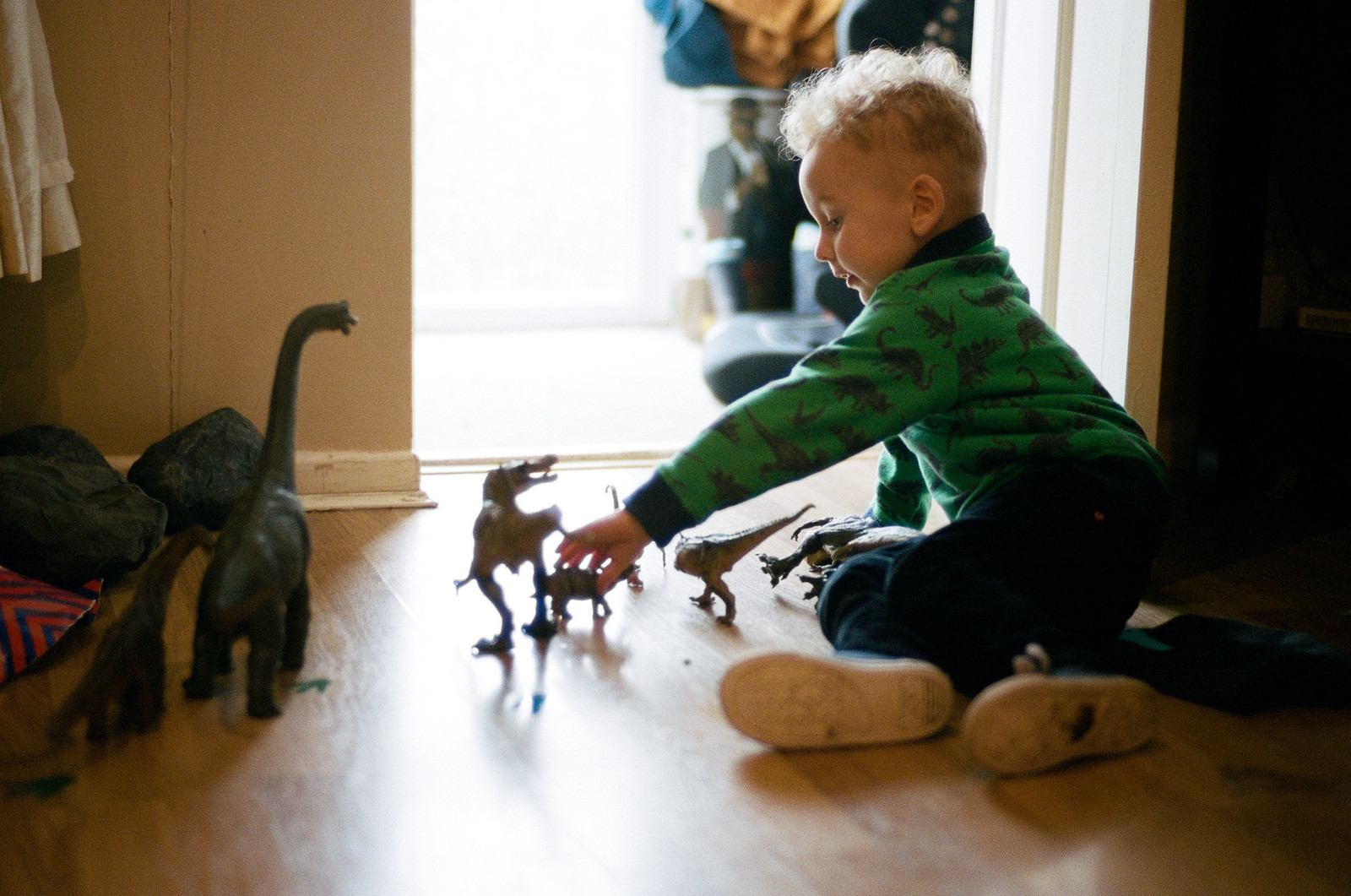
On the surface, all of the above might seem quite the feat? This is surely the best rangefinder camera viewfinder experience available? Unfortunately, whilst close to perfect, depending on your perspective (literally), the viewfinder is unfortunately not without flaw.
Rangefinder patch fade
I’m going to call what I see as a problem with the Zeiss Ikon’s rangefinder patch “rangefinder patch fade”. I’m sure someone more knowledgeable than I am will correct me with a real name phenomenon… The problem occurs when the rangefinder patch is viewed slightly off angle; anything other than viewed straight through the finder and the patch just disappears. To start with I put this down to the patch itself being poor, as I kept on finding it a little weak or hard to see.
That was until I realised there was no correlation with the amount or type of light within which I was seeing the problem. Baffled for a little while, I started experimenting with it, actively trying to work out why I was seeing this faded RF patch. What I eventually realised – with a little bit of a slap of my forehead when I did – is that the rangefinder is actually just sensitive to the angle with which it is looked through. Unfortunately for me, I was seeing it more often as the most comfortable position for the camera against my face/nose gave an ever so slightly off-angle view through the finder. In short, if you want a bright rangefinder patch, make sure you look straight through the centre of the viewfinder.
The light meter
Also visible in the viewfinder is the light meter readout. I say visible, it is visible if you look through the finder at the right angle and not when you’re shooting into light. Functionally, just like when picking up a Voigtlander R2/3/4a for the first time, picking up the Zeiss Ikon makes you realise just how easily the Leica M7 meter readout could be improved upon. It’s only flaw is that you just can’t see the readout in all circumstances. But let’s just skip over that issue on to the things that make it better than the Leica M7.
It’s not that I don’t like the M7 meter, and in fact, having recently reviewed the Leica M6 and seeing how familiar the TTL version is to the M7 in manual mode, I can see why they did it that way. Familiarity from one Leica to the next was probably quite important to Leica given how things went with the Leica M5.
Of course for Zeiss, the Ikon was a clean slate, they had no previous legacy users to upset by making the light meter readout work however they saw fit. What they created was a system that displays readings similarly to that of the Voigtlander AE rangefinders. The only real difference being that the readings are displayed up the left hand side of the finder as opposed to across the bottom, as in the Voigtlander.
Meter readout display
In manual mode the appropriate speed for correct exposure flashes, whilst the selected shutter speed remains constantly illuminated. Once you adjust the shutter speed to the speed the meter is indicating, the flashing stops. In autoexposure mode the automatically selected shutter speed just appears illuminated. If it’s blinking quickly on 1/2000 or 1 second it’s out of range. Both manual and auto are therefore very simple to understand, just like they are in the Voigtlander cameras. Fortunately, this is where the comparison with the Voigtlander cameras ends.
Metering pattern
Probably my biggest complaint about the metered Voigtlander cameras is their metering pattern. Going back to a Voigtlander after shooting the Leica M7, it just felt counter intuitive to meter meter with. This was entirely down to its metering pattern be focused toward the lower left of the frame. The Leica M7 with its centre weighted meter allows the user to gain a level of understanding of the light that has always felt to me to be near perfect.
Centre weighted meters feel to me like they provide a quick way to understand a series of averages around a scene that allow me to make a quick and broadly informed decision about exposure. Picking up the Zeiss Ikon and discovering that it’s meter is, just like the M7, centre weighted was a big relief. I figured the transition from one camera to the other would be a lot smoother. Of course I was wrong, there are subtle differences in the way the cameras actually work that meant adjusting from one to the next wasn’t going to be as smoother ride as I’d hoped… Despite this, surprisingly I found the ikon to be better suited to how I shoot now.
The Zeiss ikon Auto Exposure (in use, vs. The Leica M7)
The beauty of the M7 is the simplicity of the AE function. Point it around the scene you wish to shoot, and it gives you a set of meter readings. Pick the area of the scene you want to meter from, half press the shutter to lock in the shutter speed, reframe and shoot. It’s brilliant. I go in to more detail in my M7 review. The problem with the Leica M7 is when you switch to manual and the shutter speed readings in the viewfinder get replaced by three LEDs for under, correct and over exposure. This is the same system found in the Leica M6 TTL, the same system that as I discuss in my M6 review feels neither here nor there to me. It’s a useful meter, but it’s a bit basic and I find that it can be quite slow to use.
The Zeiss Ikon on the other hand is brilliant in manual mode. Since it tells both selected and ideal light meter readings, even in manual mode, getting that feel for the correct exposure is really easy to do. You just point the camera around the scene, watch the meter changing, make a judgment and then even without moving the camera from your eye you can set the shutter speed (with the nice big easy to click dial) to the most appropriate speed, reframe and shoot. The process is the same as with the M7, it’s just not automated.
But of course the Zeiss Ikon is automated. Unfortunately, slightly frustratingly – despite this elegant manual mode – the Zeiss Ikon auto exposure is quite subtlety, but also quite definitely let down by a single shortfall in the camera’s design. Unlike the Leica M7, the Zeiss Ikon’s exposure lock isn’t activated upon half press, it’s activated by a button on the back of the camera.
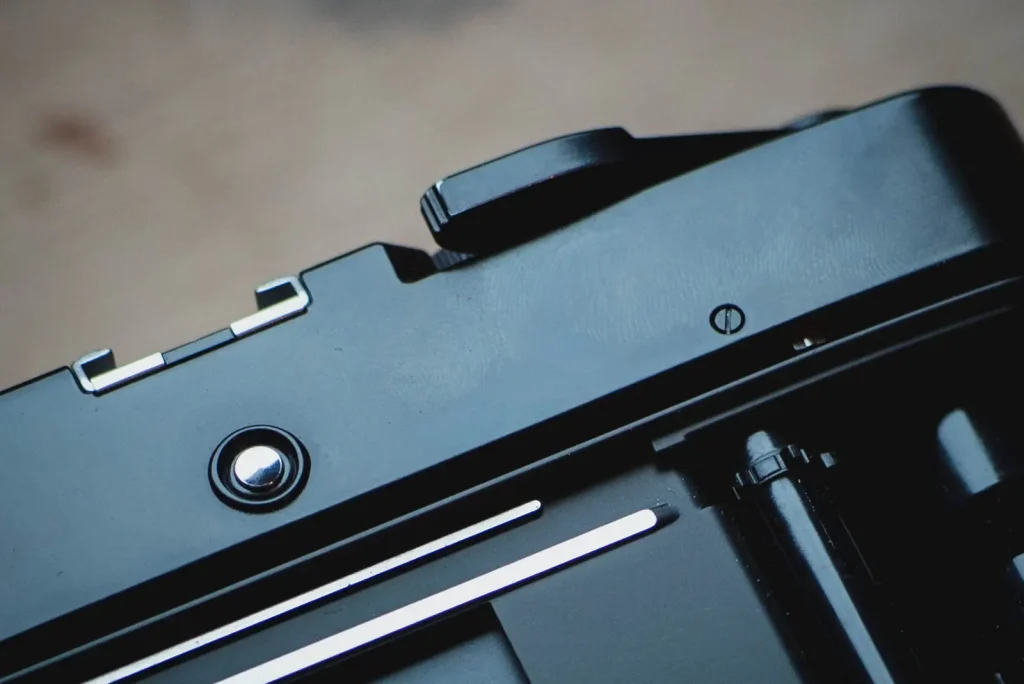
This button is placed just outside of an ergonomically comfortable position when your finger is on the shutter. This means that when holding the camera to the eye with a finger on the shutter, the reach to the AE lock just feels like it interrupts and slows down the process.
This frustration is even further compounded by how the button works. A single quick click locks exposure for 20 seconds, a second unlocks it on command. If this button had been placed where your thumb rests on the back of the camera, and if pressing it kept it locked until it was pressed again, regardless of time frame, I think it would have been perfect. In fact combined with the much better designed exposure compensation dial it would have allowed the Zeiss Ikon to feel that little bit more intuitive, and give a greater sense of control in auto mode. This in turn would have put its AE function right in line with how good I think the M7 is. As it stands, literally for nothing more than the position and function of a single button, the M7 remains king of the autoexposure rangefinders in my world!
What this all means for me
Interestingly, this personally perceived shortfall in AE function is not at all important within what I’m now looking for in a camera. My desire to use auto exposure has dwindled gradually but quite significantly over the last 2 years. To the point in fact that I’d stopped using it on the M7, instead favouring manual mode. This had meant that the M7 had almost become an M6 to me, and if you’ve read my M6 review you will know that this isn’t ideal for me.
The Zeiss Ikon’s centre weighted meter combined with a manual mode that feels more intuitive than that of the M7, makes the Zeiss Ikon a better fit to the photographer I am now… These days I am more of a a manual mode photographer, and in manual mode this camera definitely outperforms the M7, at least in terms of the way it enables me to shoot through its meter readout display.
Was I right to replace my M7 with it? I’m not sure to be honest. With it sat on my shelf I don’t just reach for it as a default choice as I did with the Leica. More often than not I’m still reaching for the M-A or the M3. Does this make the Zeiss Ikon a worse camera? No it most certainly doesn’t – I’ve just personally grown accustomed to and discovered a preference for the feel and function of my manual Leicas. I know this is just preference because when I stop and think about the Zeiss Ikon more objectively, when I weigh it’s pros and cons against that of the other autoexposure M-mount cameras I’ve shot with, there is no doubt in my mind that objectively it’s every bit as good as a Leica.
The Zeiss Ikon vs…
Preference really is the only arbiter in separating the Zeiss Ikon from the Leica M7. I couldn’t say this talking about the Voigtlander rangefinder series, as with their short RF base length and odd metering pattern, compared to these two cameras they just lack a little (not a lot, but a little) in the specifications and build quality to hold their own in this company.
I must admit, when I first started writing this post I expected to come to the same conclusion about the Zeiss Ikon – I just didn’t think I’d see it as good a camera as the M7. But, now I’ve spent the time using the camera, I find it’s just not possible to rank it as a lesser camera. What’s most interesting is that for every shortcoming I can attribute to either camera, there comes with it an opposing benefit that levels the argument.
Take for example the Zeiss Ikon and it’s lighter weight. It’s light and therefore more comfortable to carry for longer which is a preference for some people. The Leica M7 feels more solid and hardy, which is a preference for others.
Then there’s the viewfinder in the Zeiss Ikon which is bigger and it’s possibly even brighter than the M7. But of course the M7 has more frame lines which are useful if you need them, though might be seen to get in the way if you don’t. The ikon has a longer rangefinder base length, but the rangefinder patch fades quite easily, whereas the M7 RF is pretty consistent. The light meter readout is more useful in the Zeiss Ikon, but it’s always visible in the Leica. The auto exposure is a dream in the M7, but metered manual exposure is better in the Zeiss Ikon.
There are even quite subtle differences that I’ve not covered above that set the playing field quite level. The best example of this is where both cameras need batteries to run, they handle that problem slightly differently. Where the M7 has a mechanical fall back to 1/60th and 1/125 if the batteries fail, it doesn’t give you any warning that they are going to fail it just stops working and says ‘bc’ in the VF. The Zeiss Ikon doesn’t have a fall back mechanical speed, but it does give you good warning that the batteries are failing by flashing LEDs in the viewfinder. Which is the right answer to the problem? Neither, they are both imperfect, some will find either works better for them.
I could go on, but the point I’m clearly trying to make is that whilst neither camera is perfect, either might just be more perfect for any one individual. What’s frustrating for me is that I can’t even come to my own personal conclusion about which is better. Ultimately, I’m left with a preference for the feel of a Leica M7, but the functions of the Zeiss Ikon as a metered camera is better suited to me.
Summary/Conclusion (skip to the end)
As I said at the beginning of this post, the Zeiss Ikon feels like it came from a idea to better the Leica M7. Whilst in many ways it achieves this goal, as mentioned, the Leica always has an opposing related feature that in turn one ups a feature of the Zeiss Ikon. In many cases this is just down to the Ikon not working quite as well as it should. As such, it’s impossible for me to say that the Zeiss Ikon is a better camera than the Leica. But, what surprises me the most, is that I find myself also unable to say the Leica M7 is a better camera the the Zeiss.
Ultimately the Zeiss Ikon is without doubt a superb bit of kit. For the right photographer, this camera will make any Leica seem archaic and redundant. Am I that photographer? Well, in a way I am. Personal preference has seen it supersede the M7 in my collection. But it’s only my brain that’s telling you that, my heart still remains with the M7… I just wasn’t getting what I needed from it any more. Would I have sold the M7 if it were my only Leica? No absolutely not, having the M-A and M3 give me all I need from a Leica now. In fact I’d argue that a manual Leica gives me all I need from a camera now, full stop.
Yet despite this, I can’t help finding myself wanting to keep hold of this Zeiss Ikon. It just seems the logical thing to do. The big bright viewfinder, accurate (though slightly flawed) rangefinder, the near perfect (though also slightly flawed) metered functionality add up to make a camera that suits me well. Yet despite this, I don’t feel drawn to it in the way I do to my Leicas. This might sound like the wishy washy words of a Leica fan, and they probably are… But there are just some cameras – primarily my Leicas – that make me want to shoot them. I’m not entirely sure the Ikon has that same attraction to me.
But, if you’re one of those people that doesn’t get that warm feeling from a Leica, one of those that just wants a tool to do a job and do it very well, then you’re probably also one of the people that would say the Zeiss Ikon is the best autoexposure rangefinder ever made.
Thanks for reading,
Hamish
Before I close with a few links I just want to thank my good mate Pete for the very extended loan of this camera before I agreed to buy it from him.
You can find more photos here on my flickr
The Zeiss Ikon on Zeiss’s website
Roger Hicks’ review
Share this post:
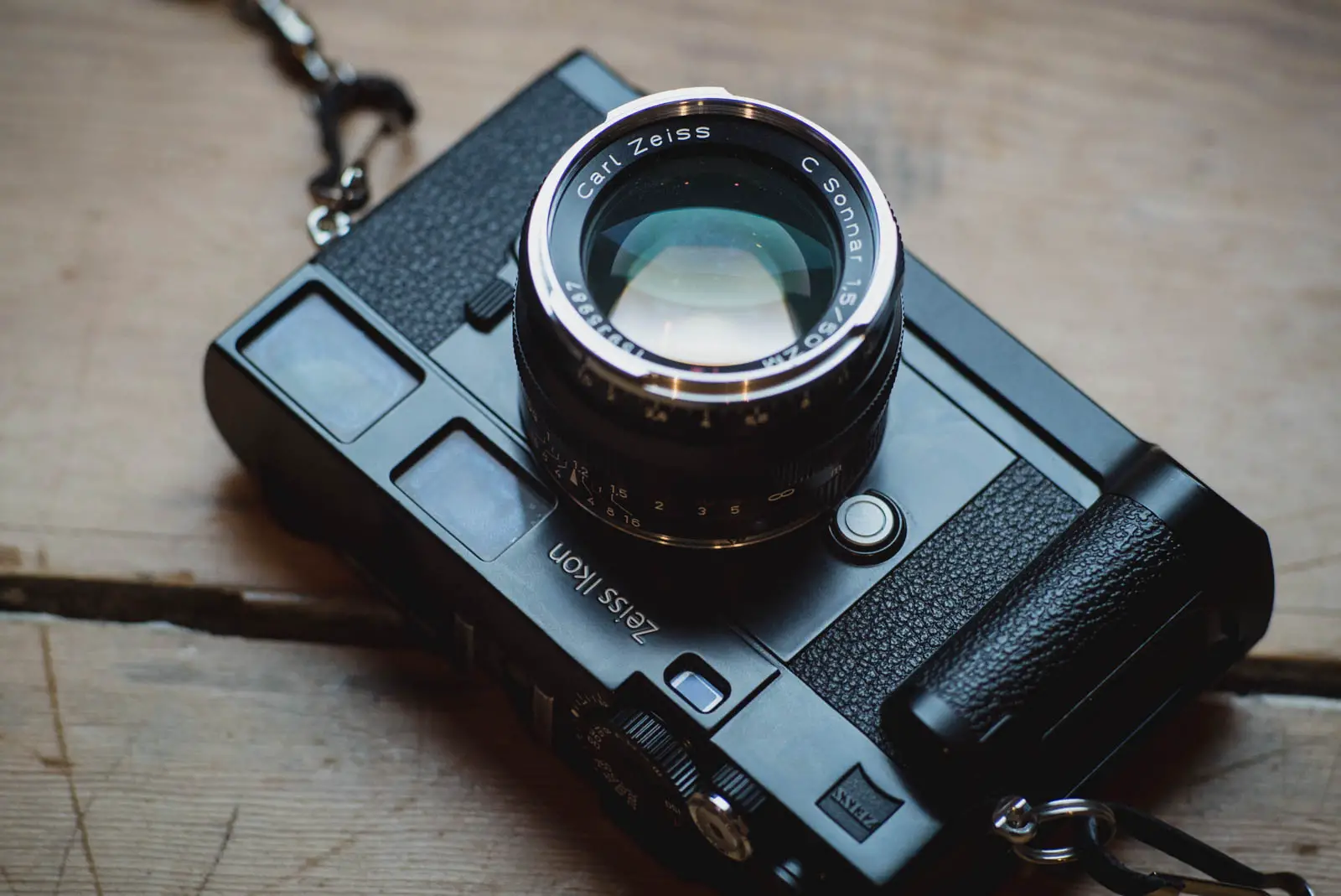
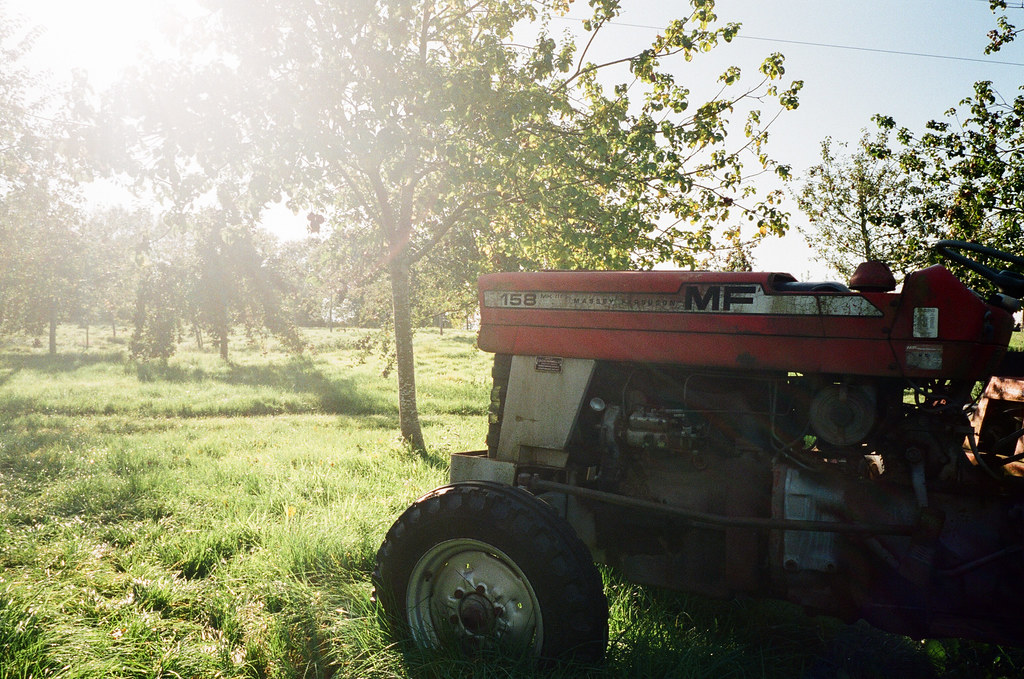


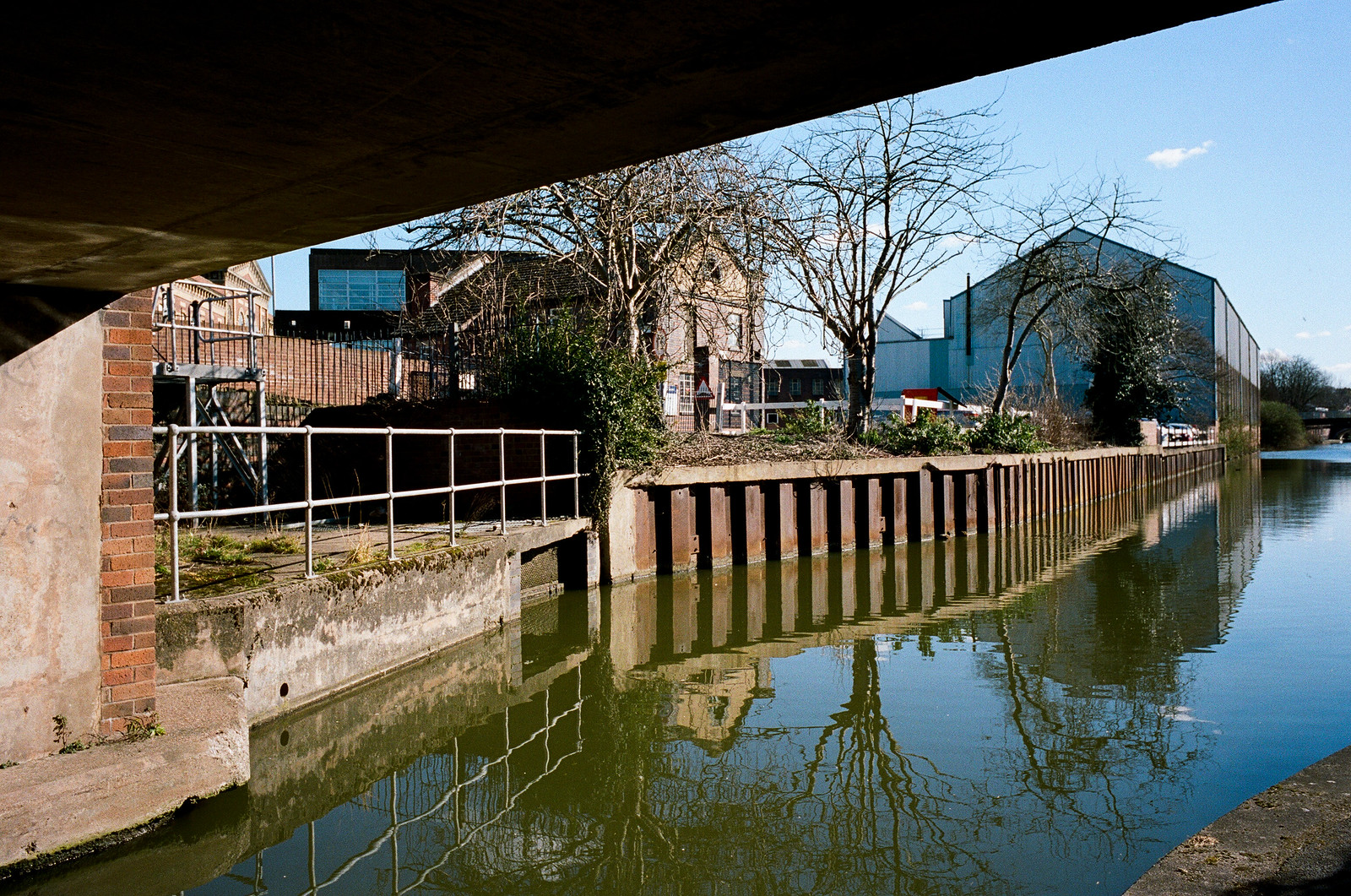








Comments
jeremy north on Zeiss Ikon ZM Review – The Ultimate AE M-mount Rangefinder…?
Comment posted: 19/03/2016
The weight thing reminds me of a line in Jurassic Park when the kid asks if the binocular thing is expensive. "is it heavy?", 'yes', "then it's expensive". I think as you said some of the weight saving is due to being made of magnesium or titanium. I don't think the body of the camera is made of pressed metal, though the bottom plate etc probably are. I think I read somewhere that the Ikon is manufactured by Cosina. I'm sure it is beautifully made along the lines of the amazing Contax G cameras.
I agree that the AE lock is in a daft place. While I love Zeiss lenses, I'm a bit disappointed that the Ikon lacks the elegant lines of a Leica. Still it is how it works which counts. I'm glad to hear it is every bit as good as its reputation.
Comment posted: 19/03/2016
Comment posted: 19/03/2016
Comment posted: 19/03/2016
Comment posted: 19/03/2016
Rob MacKillop on Zeiss Ikon ZM Review – The Ultimate AE M-mount Rangefinder…?
Comment posted: 19/03/2016
Comment posted: 19/03/2016
Stephen J. on Zeiss Ikon ZM Review – The Ultimate AE M-mount Rangefinder…?
Comment posted: 19/03/2016
Have you thought about the delights of a Konica RF? It is arguably a closer competitor to the Leica M7...
I have a friend who took some very successful (commercial) shots of entertainers and royalty etc. with this camera, and despite the fact that he now uses Canon SLR, he still cherishes his Konika RF.
Comment posted: 19/03/2016
Stephen J. on Zeiss Ikon ZM Review – The Ultimate AE M-mount Rangefinder…?
Comment posted: 19/03/2016
Yes, even though I love my Leica M2, film is definitely no longer dominant.
Comment posted: 19/03/2016
Dominik Mrzyk on Zeiss Ikon ZM Review – The Ultimate AE M-mount Rangefinder…?
Comment posted: 19/03/2016
Also, very nice shots, Hamish! :)
Comment posted: 19/03/2016
John on Zeiss Ikon ZM Review – The Ultimate AE M-mount Rangefinder…?
Comment posted: 19/03/2016
Comment posted: 19/03/2016
Alexis on Zeiss Ikon ZM Review – The Ultimate AE M-mount Rangefinder…?
Comment posted: 21/03/2016
I'm shooting extensively with this camera i.e. my old (1956) M3 is gathering dust eversince I had my ZM. The ZM viewfinder to this day baffles me.
There is one of your cons that I consider pro, user preference I know, but that might help someone closer to my preferences than yours so here is my opinion for the other crowd, just in case I am not alone ;) :
Regarding AE lock I have never been fond of the shutter release half-press lock system, for one reason only: when under time pressure, it is far too easy to miss the half-press and push the shutter release all to way down to the triggering point.
I like binary button behaviors so I know they do one thing only and my job is just to push it however hard I want at the time "of my choosing" - to quote one of your most recent shakespearian speaking president :) -
So in this regard I consider the AE lock button design on the ZM a clear success, and as you pointed out, it does feel the camera was designed to be the best tool for image making photographers, and not so much for the oh-my-gear crowd ;)
A typical exemple for me is: camera in hand on my side (at pants pocket level, so not to my eye) pointing the camera toward the pavement to lock AE exposure, one thumb press, bam AE locked, then I just have to raise the camera to my eye, frame and shoot. Half pressing in this situation is almost impossible to achieve without accidental release.
Camera to the eye it's still ok for right eye shooters, a bit more cumbersome I reckon but still manageable for lefties ones which I am.
All this is user preference, so to each is own.
One thing that is a minus to me is the on/off switch which I would have liked to function the other way around. The way the trigger finger lands on the camera when not to the eye ie finger wandering around the trigger release is prone to accidental switch off. I would very much prefer (and may likely ask for a custom inversion of said switch) the switch to be prone to accidental switch on rather than off as this did cost me a few shots.
To me pros are:
A-ma-zing viewfinder big, bright, not cluttered, large RF patch, I wear glasses
Light weight
Large shutter speed dial, turning the proper way around
Not seeing the meter reading if I don't look at it (not annoying)
Meter reading and AE functions well designed
To me cons are:
Minor: Take-up spool design, this is slow loading, leica M4 like take-up spool IS quicker to load
Minor: Rewinding lever is not too easy to get out when not having protruding nails which I don't have so it slows me downs a bit more than I'd like to
Minor: RF patch indeed disappears when not looked at at a facing angle, more of a night time issue, but who chooses a RF to focus all day long ?
Major: The ON/OFF switch is the major one for me, too prone to accidental switch off
Mechanical cameras still rule for me, I hate the battery dependant thingy, but as you mentionned this one does warn you well in advance (2 rolls at least). This metered baby is probably the the best tool a photographer would wish to use, Zeiss knows so much about making tools that can work hard. They should have our praised for not having fallen into making good looking gear for the dentist crowd ie we can still buy amazing super pro grade TOOLS to work with, let us not start about their glass, Zeiss rules!
Sorry dentist buddies, I love you guys ( when you're not torturing me) but you have to reckon you hobbies are driving the market in a difficult place for the non medical professionnals to attain ;)
Cheers all !
Comment posted: 21/03/2016
Alexis on Zeiss Ikon ZM Review – The Ultimate AE M-mount Rangefinder…?
Comment posted: 22/03/2016
True I love all mechanical babies, but this one will stay with me.
Cheers !
Comment posted: 22/03/2016
Alejandro Ilukewitsch on Zeiss Ikon ZM Review – The Ultimate AE M-mount Rangefinder…?
Comment posted: 06/05/2016
Ryan on Zeiss Ikon ZM Review – The Ultimate AE M-mount Rangefinder…?
Comment posted: 09/06/2016
The Zeiss is a pleasure to use on so many levels. After having a M3 and owning the M-A, the rear swing door is a nice treat versus having to remove the baseplate and flip open the trap door. Changing film is quick and intuitive. I'm not sure you mentioned above, but while the Ikon shows full shutter speeds in the left vertical pane of the viewfinder, it is capable of 1/12 stop shutter speed increments. I've seen some conclude that this, coupled with the Zeiss ZM lenses' 1/3 stop aperture ring makes it the ideal camera for slide films. I have no wayto confirm this as I shoot almost exclusively color neg with my Zeiss (the M-A having almost solely Tri-X in it).
I would agree with one commentator above. If you're eye is not perfectly aligned with viewfinder the patch will disappear. It can be frustrating but I found in a few rolls that the camera will correct your deficiencies.
Through a lot of use I've found the meter to be as accurate as a center-weighted averaging meter can be, with the same faults as those used in film Leicas.
Funny, I came upon you site (I've read much of it prior) doing to research on a M6, thinking that I may want to add one. After reading your review, it makes me realize what a great camera the Zeiss is. Maybe I'll just get another!
Comment posted: 09/06/2016
rollbahn on Zeiss Ikon ZM Review – The Ultimate AE M-mount Rangefinder…?
Comment posted: 01/11/2016
However as tools to photograph I find the Ikon just perfect for me. As I wear glasses the VF is ideal and the clarity is beyond anything I have used on a Leica except maybe an M3. The way the Ikon shows where your shutter speed is in relation to what you've set manually is exactly how I want it rather than an M6 where you are left guessing.
So I love my Ikon but I just keep putting a roll in my M4-2 with the viewfinder where I can only see 75% of the frame because of my glasses and no meter (I use a Sekonic 308 most of the time anyway) and all the other little issues like 1/50th flash speed, no ability to see what film I have loaded etc etc. But once you pick up the Leica the difference is night and day - Rolex compared to a Seiko - Seiko is great and will get the job done but the Rolex is a thing of beauty if watches are your thing.
I was thinking of testing an M7 as something that may solve the issues but your reviews on the M7 have put me off that a little.
Anyway first world problems I know but it's interesting to see someone going through exactly the same issues.
Comment posted: 01/11/2016
Comment posted: 01/11/2016
Neil on Zeiss Ikon ZM Review – The Ultimate AE M-mount Rangefinder…?
Comment posted: 08/02/2017
Konstantin V. on Zeiss Ikon ZM Review – The Ultimate AE M-mount Rangefinder…?
Comment posted: 23/07/2017
"Advocates of the Zeiss Ikon ZM are always very quick to point out just how good the viewfinder is compared to Leica viewfinders. This really is one area where it feels like the intention was to better anything from the Leica stables. There’s good reason for this too, it is in fact both bigger and brighter than any of my Leica viewfinders, including the M-A, which is in its own right a stunning viewfinder."
was completly missleading in my case. I've read this review and got Zeiss Ikon. I shoot with it for about 3 month and then it became fall apart. Rubber on a viewfinder started to flake off. Bottom is made of plastic, not metal. Easy to scratch. "Ears" for a strap started to bend under camera's own weight. Previous owner was very accurate, I'm not. Camera got into rain and shutter said "game over" for a while. I ended up with Leica M-A and want to say it's completly different subject. And the viewfinder actually IS better! Zeiss Ikon's wasn't bright at all! The patch of ZI not only disappears, but it lacks contrast that much I couldn't use it sometimes. It's a tad bigger, but it doesn't count when you look into modern leica's viewfinder. So if anyone is on a crossroad as I was... you have my 2 cents now. ZI is just a cheap camera and Leica M-A is on completly different level.
David B on Zeiss Ikon ZM Review – The Ultimate AE M-mount Rangefinder…?
Comment posted: 07/09/2017
No. The M7 has two -m-e-c-h-a-n-i-c-a-l- shutter speeds (..1/60th and 1/125th..) and so it works even without any batteries at all.
Comment posted: 07/09/2017
Ryan on Zeiss Ikon ZM Review – The Ultimate AE M-mount Rangefinder…?
Comment posted: 10/09/2017
Malaparte on Zeiss Ikon ZM Review – The Ultimate AE M-mount Rangefinder…?
Comment posted: 06/02/2019
To get a better opinion about the photographic tool its better to check the ken rockwell site.
Comment posted: 06/02/2019
Shooting the new Voigtlander Ultron 35mm f/2 ASPH in Hong Kong – By Ong Sien Hong - 35mmc on Zeiss Ikon ZM Review – The Ultimate AE M-mount Rangefinder…?
Comment posted: 24/04/2019
5 Frames With... Rollei CR200 (EI 200 / 35mm / XPRO / Zeiss Ikon ZM) - by Alexis Analog | EMULSIVE on Zeiss Ikon ZM Review – The Ultimate AE M-mount Rangefinder…?
Comment posted: 02/02/2020
Marc Wick on Zeiss Ikon ZM Review – The Ultimate AE M-mount Rangefinder…?
Comment posted: 25/04/2020
Comment posted: 25/04/2020
Thuc on Zeiss Ikon ZM Review – The Ultimate AE M-mount Rangefinder…?
Comment posted: 22/10/2020
Comment posted: 22/10/2020
jason gold on Zeiss Ikon ZM Review – The Ultimate AE M-mount Rangefinder…?
Comment posted: 01/08/2022
Sasha Tsyrlin on Zeiss Ikon ZM Review – The Ultimate AE M-mount Rangefinder…?
Comment posted: 06/08/2024
Sasha Tsyrlin here. I wrote an article for you a couple of years back about Jupiter-3 which Chris did some magic on for me. Slightly off topic question. Have you ever used Zeiss Ikon SW, blind version of ZM? I am tempted to get it as a wide point and shoot.Will shoot VC Skopar 28mm LTM with a finder. I bought and sold a Leica MDA twice, it never really clicked with me. I know you had an MDA and it did find a need for for it. I might be having a similar problem:) Or may be get black MD-2 and see if the 3rd time will be a Leica charm:)) May be it's just about a color:)) Any 10 cent input will be appreciated :)
Hard to like anything after M3 and IIIf which I have.